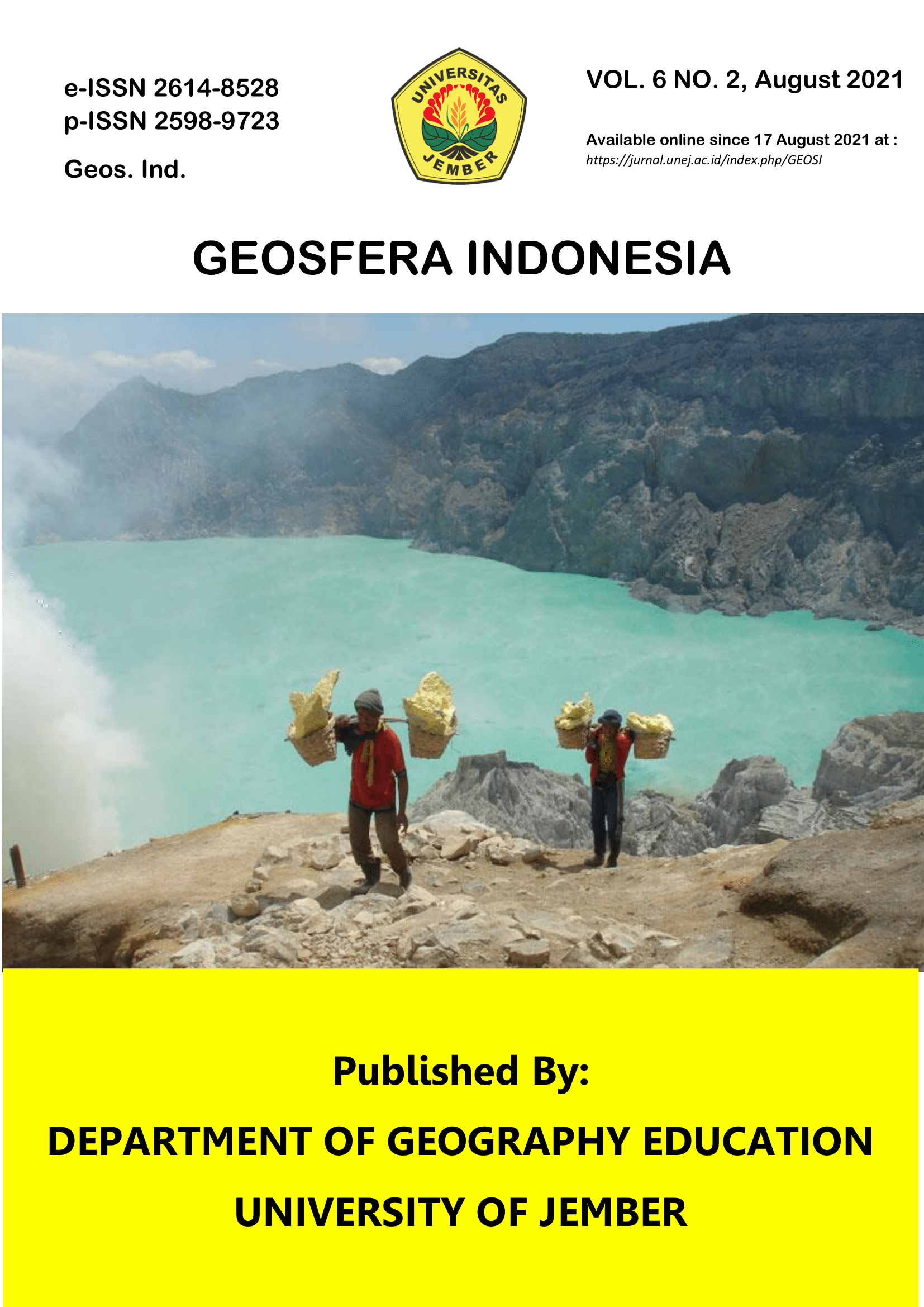Flash Flood Susceptibility Mapping at Andungbiru Watershed, East Java Using AHP-Information Weighted Method
DOI:
https://doi.org/10.19184/geosi.v6i2.24173Keywords:
AHP-Weighted, Information Content, FFSP, GIS, GeomorphologyAbstract
Flash floods are among the most frequent natural disasters caused by heavy rain associated with a severe thunderstorm, which leads to social and economic losses in infrastructure and agriculture. Therefore, this research aims to map flash flood potential susceptibility (FFPS) in the Pekalen watershed, using Geographic Information System (GIS) technology and statistical analysis to reduce the risk of flooding. The opinion and experience of an expert on the weight assessment method were carried out using the Analytical Hierarchy Process (AHP). Furthermore, the probability statistical methods and GIS were used in flash flood areas in the Pekalen watershed in Andungbiru, Probolinggo village. This study was carried out using geomorphological factors, namely elevation, slope, stream power index, and topographic wetness index, with a resolution of 30 m. Thematic map scale of the land use, river density, distance to the river, rainfall, and geology is in the ratio of is in a ratio of 1:25.000. Imagery processing was carried out using Landsat 8 30 m x 30 m resolution imagery, such as the Normalized Difference Vegetation Index. The result showed that the model map of FFPS obtained low 8%, low 23%, moderate 27%, moderate to high 26%, high 13%, and very high 2% index values. The next stage of modeling analysis led to validation using statistic receiver operating Characteristic Curve (ROC) of area Under Curve (AUC) with a value of 90.15. In conclusion, the factors that significantly trigger flash floods are distance to the river, land use, and slope.
Keywords: AHP-weighted; information content; FFSP; GIS; Geomorphology
Copyright (c) 2021 Geosfera Indonesia and Department of Geography Education, University of Jember

This work is licensed under a Creative Commons Attribution-Share A like 4.0 International License
Downloads
References
BIG (1999). Peta RBI Format shp. Retrieved from https://tanahair.indonesia.go.id/portal-web.
Bui, D. T., Tsangaratos, P., Ngo, P. T. T., Pham, T. D., & Pham, B. T. (2019). Flash flood susceptibility modeling using an optimized fuzzy rule based feature selection technique and tree based ensemble methods. Science of the Total Environment, 668, 1038–1054. https://doi.org/10.1016/j.scitotenv.2019.02.422.
Cao, C., Xu, P., Wang, Y., Chen, J., Zheng, L., & Niu, C. (2016). Flash flood hazard susceptibility mapping using frequency ratio and statistical index methods in coalmine subsidence areas. Sustainability (Switzerland), 8(9). https://doi.org/10.3390/su8090948.
Cloke, H. L., & Pappenberger, F. (2009). Ensemble flood forecasting: A review. Journal of Hydrology, 375(3–4), 613–626. https://doi.org/10.1016/j.jhydrol.2009.06.005.
Costache, R., Pham, Q. B., Sharifi, E., Linh, N. T. T., Abba, S. I., Vojtek, M., Vojteková, J., Nhi, P. T. T., & Khoi, D. N. (2020). Flash-flood susceptibility assessment using multi-criteria decision making and machine learning supported by remote sensing and GIS techniques. Remote Sensing, 12(1). https://doi.org/10.3390/RS12010106.
Du, J., Fang, J., Xu, W., & Shi, P. (2013). Analysis of dry/wet conditions using the standardized precipitation index and its potential usefulness for drought/flood monitoring in Hunan Province, China. Stochastic Environmental Research and Risk Assessment,27(2), 377–387. https://doi.org/10.1007/s00477-012-0589-6.
Elkhrachy, I. (2015). Flash Flood Hazard Mapping Using Satellite Images and GIS Tools: A case study of Najran City, Kingdom of Saudi Arabia (KSA). Egyptian Journal of Remote Sensing and Space Science, 18(2), 261–278. https://doi.org/10.1016/j.ejrs.2015.06.007.
Fernández, D. S., & Lutz, M. A. (2010). Urban flood hazard zoning in Tucumán Province, Argentina, using GIS and multicriteria decision analysis. Engineering Geology, 111(1–4), 90–98. https://doi.org/10.1016/j.enggeo.2009.12.006.
Moore, I. D., Grayson, R. B., & Ladson, A. R. (1991). Digital terrain modeling: A review of hydrological, geomorphological, and biological applications. Hydrological Processes, 5(1), 3–30. https://doi.org/10.1002/hyp.3360050103.
NASA (2020). Shuttle Radar Topography Mission (SRTM). Retrieved from https://cmr.earthdata.nasa.gov/search/concepts/C1000000240-LPDAAC_ECS.html.
Guzzetti, F., Stark, C. P., & Salvati, P. (2005). Evaluation of flood and landslide risk to the population of Italy. Environmental Management, 36(1), 15–36. https://doi.org/10.1007/s00267-003-0257-1.
He, H., Hu, D., Sun, Q., Zhu, L., & Liu, Y. (2019). A landslide susceptibility assessment method based on GIS technology and an AHP-weighted information content method: A case study of southern Anhui, China. ISPRS International Journal of Geo-Information, 8(6). https://doi.org/10.3390/ijgi8060266.
Khosravi, K., Nohani, E., Maroufinia, E., & Pourghasemi, H. R. (2016). A GIS-based flood susceptibility assessment and its mapping in Iran: a comparison between frequency ratio and weights-of-evidence bivariate statistical models with multi-criteria decision-making technique. Natural Hazards, 83(2), 947–987. https://doi.org/10.1007/s11069-016-2357-2.
Kia, M. B., Pirasteh, S., Pradhan, B., Mahmud, A. R., Sulaiman, W. N. A., & Moradi, A. (2012). An artificial neural network model for flood simulation using GIS: Johor River Basin, Malaysia. Environmental Earth Sciences, 67(1), 251–264. https://doi.org/10.1007/s12665-011-1504-z.
Penning-Rowsell, E., Floyd, P., Ramsbottom, D., & Surendran, S. (2005). Estimating injury and loss of life in floods: A deterministic framework. Natural Hazards, 36(1–2), 43–64. https://doi.org/10.1007/s11069-004-4538-7.
Popa, M. C., Peptenatu, D., Draghici, C. C., & Diaconu, D. C. (2019). Flood hazard mapping using the flood and Flash-Flood Potential Index in the Buzau River catchment, Romania. Water (Switzerland), 11(10). https://doi.org/10.3390/w11102116.
Pradhan, B, & Shafie, M. (2009). Flood hazard assessment for cloud prone rainy areas in a typical tropical environment. Disaster Advances, February.
Pradhan, Biswajeet, & Lee, S. (2010). Delineation of landslide hazard areas on Penang Island, Malaysia, by using frequency ratio, logistic regression, and artificial neural network models. Environmental Earth Sciences, 60(5), 1037–1054. https://doi.org/10.1007/s12665-009-0245-8.
Salvati, P., Bianchi, C., Rossi, M., & Guzzetti, F. (2010). Societal landslide and flood risk in Italy. Natural Hazards and Earth System Science, 10(3), 465–483. https://doi.org/10.5194/nhess-10-465-2010.
Tehrany, M. S., Pradhan, B., & Jebur, M. N. (2013). Spatial prediction of flood susceptible areas using rule based decision tree (DT) and a novel ensemble bivariate and multivariate statistical models in GIS. Journal of Hydrology, 504, 69–79. https://doi.org/10.1016/j.jhydrol.2013.09.034.
Tehrany, M. S., Pradhan, B., & Jebur, M. N. (2015). Flood susceptibility analysis and its verification using a novel ensemble support vector machine and frequency ratio method. Stochastic Environmental Research and Risk Assessment, 29(4), 1149–1165. https://doi.org/10.1007/s00477-015-1021-9.
USGS (2020). Landsat 8. Retrieved from https://www.usgs.gov/.
Zhang, D. wei, Quan, J., Zhang, H. bin, Wang, F., Wang, H., & He, X. yan. (2015). Flash flood hazard mapping: A pilot case study in Xiapu River Basin, China. Water Science and Engineering, 8(3), 195–204. https://doi.org/10.1016/j.wse.2015.05.002.



